Related Research Articles

Weimar culture was the emergence of the arts and sciences that happened in Germany during the Weimar Republic, the latter during that part of the interwar period between Germany's defeat in World War I in 1918 and Hitler's rise to power in 1933. 1920s Berlin was at the hectic center of the Weimar culture. Although not part of the Weimar Republic, some authors also include the German-speaking Austria, and particularly Vienna, as part of Weimar culture.

Before 1933, male homosexual acts were illegal in Germany under Paragraph 175 of the German Criminal Code. The law was not consistently enforced, however, and a thriving gay culture existed in major German cities. After the Nazi takeover in 1933, the first homosexual movement's infrastructure of clubs, organizations, and publications was shut down. After the Röhm purge in 1934, persecuting homosexuals became a priority of the Nazi police state. A 1935 revision of Paragraph 175 made it easier to bring criminal charges for homosexual acts, leading to a large increase in arrests and convictions. Persecution peaked in the years prior to World War II and was extended to areas annexed by Germany, including Austria, the Czech lands, and Alsace–Lorraine.
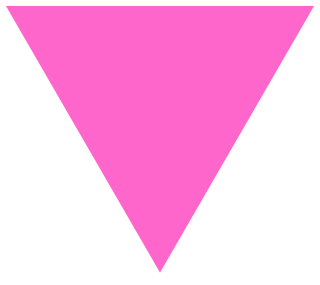
A pink triangle has been a symbol for the LGBT community, initially intended as a badge of shame, but later reclaimed as a positive symbol of self-identity. In Nazi Germany in the 1930s and 1940s, it began as one of the Nazi concentration camp badges, distinguishing those imprisoned because they had been identified by authorities as gay men. In the 1970s, it was revived as a symbol of protest against homophobia, and has since been adopted by the larger LGBT community as a popular symbol of LGBT pride and the LGBT movements and queer liberation movements.

Magnus Hirschfeld was a German physician and sexologist.
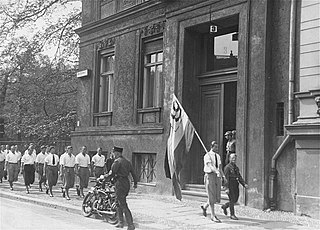
The Institut für Sexualwissenschaft was an early private sexology research institute in Germany from 1919 to 1933. The name is variously translated as Institute of Sex Research, Institute of Sexology, Institute for Sexology or Institute for the Science of Sexuality. The Institute was a non-profit foundation situated in Tiergarten, Berlin. It was the first sexology research center in the world.
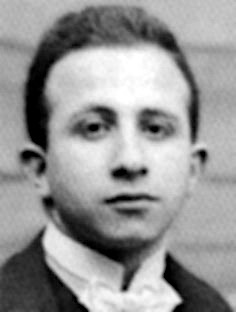
Kurt Hiller was a German essayist, lawyer, and expressionist poet. He was also a political journalist.
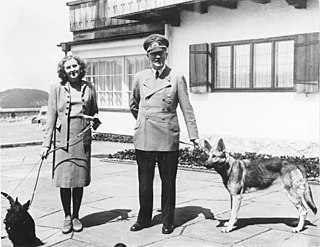
The sexuality of Adolf Hitler, dictator of Germany from 1933 to 1945, has long been a matter of historical and scholarly debate, as well as speculation and rumour. There is evidence that he had relationships with a number of women during his lifetime, as well as evidence of his antipathy to homosexuality, and no evidence of homosexual encounters. His name has been linked to a number of possible female lovers, two of whom committed suicide. A third died of complications eight years after a suicide attempt, and a fourth also attempted suicide.

A transvestite pass was a doctor's note recognized by the governments of Imperial Germany and the Weimar Republic – under the support of sexologist Magnus Hirschfeld – identifying a person as a transvestite. Transvestite at this time referred to all individuals whose gender identity or preferred clothing was discordant to that associated with their assigned sex, and so included both cross-dressing and transgender people. As gender-confirming surgery was only an emerging practice in the early 20th century, obtaining a Transvestitenschein, along with an official name change, represented the maximum extent to which many trans individuals could transition.
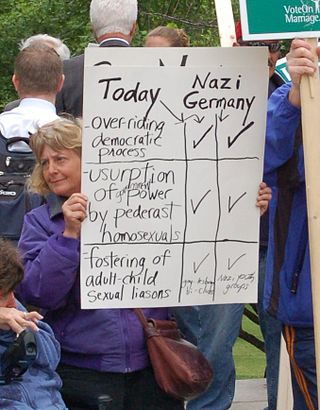
There is a widespread and long-lasting myth alleging that homosexuals were numerous and prominent as a group in the Nazi Party or the identification of Nazism with homosexuality more generally. It has been promoted by various individuals and groups both before and after World War II, especially by left-wing Germans during the Nazi era and the Christian right in the United States more recently. Although some gay men joined the Nazi Party, there is no evidence that they were overrepresented. The Nazis harshly criticized homosexuality and severely persecuted gay men, going as far as murdering them en masse. Therefore, historians regard the myth as having no merit.
Jennifer V. Evans is a professor of history at Carleton University and a competitive athlete. Her research and teaching focuses on the history of sexuality, right-wing populism and authoritarianism, especially in the context of its evolution on social media and visual culture. In 2016, she was elected a Member of the College of New Scholars, Royal Society of Canada. Her writing on fascism, authoritarianism, memory, and sexuality has appeared in major newspapers, including The Globe and Mail, The Guardian, the National Post, and the Washington Post.

In Nazi Germany, lesbians who were sent to concentration camps were often categorized as "asocial", if they had not been otherwise targeted based on their ethnicity or political stances. Female homosexuality was criminalized in Austria, but not other parts of Nazi Germany. Because of the relative lack of interest of the Nazi state in female homosexuality compared to male homosexuality, there are fewer sources to document the situations of lesbians in Nazi Germany.

The first homosexual movement was a socio-political movement which thrived in Germany from the late nineteenth century until 1933. The movement began in Germany because of a confluence of factors, including the criminalization of sex between men and the country's relatively lax censorship. German writers in the mid-nineteenth century coined the word homosexual and criticized its criminalization. In 1897, Magnus Hirschfeld founded the world's first homosexual organization, the Scientific-Humanitarian Committee, whose aim was to use science to improve public tolerance of homosexuality and repeal Paragraph 175. During the German Empire, the movement was restricted to an educated elite, but it greatly expanded in the aftermath of World War I and the German Revolution.

The Memorial to the First Homosexual Emancipation Movement is a memorial in the neighbourhood of Moabit in Berlin, Germany. Unveiled on 7 September 2017, the memorial is located opposite the Federal Chancellery on the Spree and commemorates the first homosexual movement, which was destroyed in 1933 by the Nazis, and especially the Scientific-Humanitarian Committee founded in 1897 to oppose the criminalization of homosexuality in Germany. The Scientific-Humanitarian Committee's headquarters were located on the other bank of the Spree near the Federal Chancellery. The riverbank where the memorial is located has been named the Magnus-Hirschfeld-Ufer since 2008. The memorial includes an information panel that has been in place since 2011 and discusses the movement with portraits of Anita Augspurg (1857–1943), Karl Heinrich Ulrichs (1825–1895) and Magnus Hirschfeld (1868–1935).
Acquired homosexuality is the discredited idea that homosexuality can be spread, either through sexual seduction or recruitment by homosexuals, or through exposure to media depicting homosexuality. According to this belief, any child or young person could become homosexual if exposed to it; conversely, through conversion therapy, a homosexual person could be made straight.

The Röhm scandal resulted from the public disclosure of Nazi politician Ernst Röhm's homosexuality by anti-Nazis in 1931 and 1932. As a result of the scandal, Röhm became the first known homosexual politician.

Some or all sexual acts between men, and less frequently between women, have been classified as a criminal offense in various regions. Most of the time, such laws are unenforced with regard to consensual same-sex conduct, but they nevertheless contribute to police harassment, stigmatization, and violence against homosexual and bisexual people. Other effects include exacerbation of the HIV epidemic due to the criminalization of men who have sex with men, discouraging them from seeking preventative care or treatment for HIV infection.

Elsa Conrad, nicknamed "Igel" was a German businesswoman and night club entrepreneur. In the 1930s she was arrested and interned at Moringen concentration camp by the Nazi Party and was forced to emigrate, due to her sexuality, political views and Nazi racial laws.

Li Shiu Tong was a Hong Kong Chinese (British) medical student, sexologist, and LGBTQ activist in the early twentieth century, known as the companion of German sexologist Magnus Hirschfeld.
In Nazi Germany, transgender people had a variety of experiences depending on whether they were considered "Aryan" or capable of useful work. According to the Museum of Jewish Heritage, the Nazi German government "brutally targeted the trans community, deporting many trans people to concentration camps and wiping out vibrant community structures."

Paragraph 183 is a public indecency law of the German Criminal Code, which prohibits "sexual self-determination" and public exhibitionism. From its adoption in 1871, at an increasing rate during the rise of the Nazis, and until as late as the mid-20th century, the law was used to enforce penalties for cross-dressing and homosexual acts. As of 2021, the law's scope is limited to indecent exposure.
References
- ↑ "Laurie Marhoefer | Department of History | University of Washington". history.washington.edu. Retrieved 30 December 2021.
- ↑ Jack and Anita Hess Research Seminar https://www.ushmm.org/research/opportunities-for-academics/faculty-seminars/hess/2021
- ↑ Søland, Birgitte (2018). "Gender, Sexuality, and the City in the Early Twentieth Century". Journal of Women's History. 30 (3): 188–196. doi:10.1353/jowh.2018.0037. ISSN 1527-2036. S2CID 149667976.
- ↑ Griffiths, Craig (November 2016). "Review of Beachy, Robert, Gay Berlin: Birthplace of a Modern Identity and Marhoefer, Laurie, Sex and the Weimar Republic: German Homosexual Emancipation and the Rise of the Nazis". H-Histsex, H-Review.
{{cite journal}}: Cite journal requires|journal=(help) - ↑ Oosterhuis, Harry (2017). "Sex and the Weimar Republic: German Homosexual Emancipation and the Rise of the Nazis by Laurie Marhoefer (review)". University of Toronto Quarterly. 86 (3): 226–228. doi:10.3138/utq.86.3.226. ISSN 1712-5278.
- ↑ Giles, Geoffrey J. (2016). "Sex in the Weimar Republic: German Homosexual Emancipation and the Rise of the Nazis by Laurie Marhoefer". Canadian Journal of History. 51 (3): 606–608. doi:10.3138/cjh.ach.51.3.rev21. S2CID 152266851.
- ↑ Leng, Kirsten (2016). "Sex and the Weimar Republic: German Homosexual Emancipation and the Rise of the Nazis". German History. 34 (3): 500–502. doi:10.1093/gerhis/ghw049.
- ↑ Wackerfuss, Andrew (2017). "Laurie Marhoefer. Sex and the Weimar Republic: German Homosexual Emancipation and the Rise of the Nazis". The American Historical Review. 122 (1): 268–270. doi:10.1093/ahr/122.1.268a.
- ↑ Beachy, Robert (2017). "Sex and the Weimar Republic: German Homosexual Emancipation and the Rise of the Nazis . By Laurie Marhoefer. German and European Studies. Edited by Rebecca Wittmann.Toronto: University of Toronto Press, 2015. Pp. xvi+340. $85.00 (cloth); $32.95 (paper)". The Journal of Modern History. 89 (4): 990–992. doi:10.1086/694376.